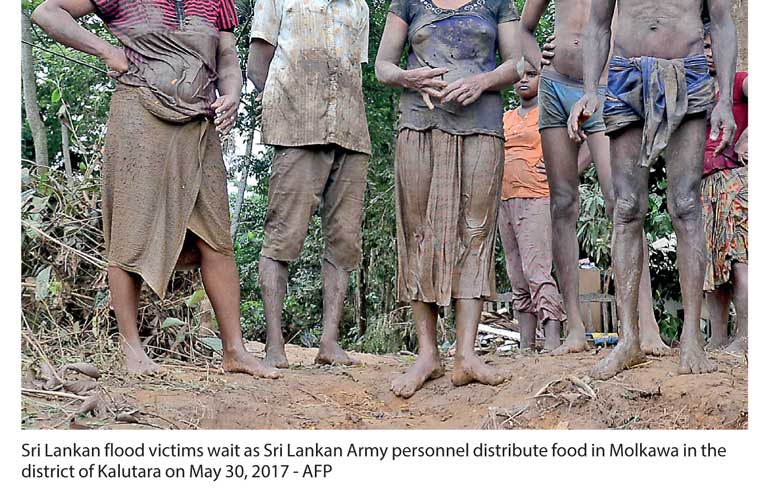Sunday Dec 07, 2025
Sunday Dec 07, 2025
Wednesday, 31 May 2017 00:10 - - {{hitsCtrl.values.hits}}
 AFP: Sri Lanka appealed Tuesday for volunteers to help with a massive clean-up after landslides and floods left at least 193 dead and tens of thousands without safe drinking water.
AFP: Sri Lanka appealed Tuesday for volunteers to help with a massive clean-up after landslides and floods left at least 193 dead and tens of thousands without safe drinking water.
The Government sought help to purify wells contaminated by the floods, the worst in 14 years after record rainfall in the island’s southwest.
The Disaster Management Centre said nearly 600,000 people had been forced from their homes. Just over 1,300 houses were completely destroyed in landslides, while nearly 7,000 suffered structural damage, according to official figures.
Water supply minister Rauf Hakeem said 40 percent of those affected had no access to piped drinking water, and there was an urgent need to purify contaminated wells in flood-hit areas.
He said 400 people had volunteered so far for a major clean-up of wells and appealed for donations of water pumps.
“Our workers have volunteered to join a major (well) clean-up,” the minister told reporters in Colombo. He said flooded pumping stations had been restored but an area just outside Colombo was still without piped water.
Government spokesman Rajitha Senaratne said many victims had started moving back into their homes as floodwaters receded but authorities remained concerned about the spread of disease.
“We have started sending additional doctors, nurses and medical supplies to prevent any outbreak of diseases such as rat fever (leptospirosis) and diarrhoea,” said Senaratne, who is also health minister.
“We could also have a dengue outbreak in about two weeks. We are very conscious of that. Additional medical teams will be checking on mosquito breeding grounds as well.”
The military has deployed more service personnel in addition to the thousands already involved in distributing food and other essentials to flood victims in the districts of Kalutara, Ratnapura, Galle and Matara.
Sri Lanka has experienced scattered showers in many parts in the past 24 hours but flood waters are rapidly receding, officials said.
In addition to the official death toll of 193, another 94 people were listed as missing as of Tuesday afternoon. In May 2003 250 people were killed and 10,000 homes destroyed after a similarly powerful monsoon.
Aid on its way
The Government announced Tuesday it would cut back spending on new vehicles to save money as Colombo sought international assistance for the clean-up.
“The Cabinet decided today that we will not purchase any cars for ministers or the Government this year in view of the natural disaster,” Senaratne said. A third aid ship was expected to arrive from India later Tuesday, Senaratne said, adding that three ships from China and another from Pakistan were also expected in Colombo this week.
Australia, Japan and Singapore were among the other nations rushing to donate inflatable boats and other aid. The UN was donating water containers, water purification tablets and tarpaulins while the World Health Organization will support medical teams in affected areas.
COLOMBO/NEW DELHI (Thomson Reuters Foundation): H eavy rains, highways buried under landslides and roads submerged under water are hampering efforts to get food, water and medicines to thousands of flood survivors in Sri Lanka, government officials and aid workers said on Tuesday.
The floods and landslides, triggered by torrential rains in recent days, have killed some 200 people and disrupted the lives of over half million others. Over 80,000 people have been forced into temporary shelters and around 100 people remain missing.
Government and military officials said the army and air force - using boats and helicopters - had managed to reach most of those affected, but persistent rains and inaccessible roads were hampering efforts to airdrop and distribute aid in some areas. “The military was able to facilitate access to three landslide areas only yesterday. Hundreds of army personnel were deployed to remove the soil mounts from the landslides,” military spokesman Roshan Seneviratne told the Thomson Reuters Foundation.
The deluge, the worst Sri Lanka has witnessed in more than a decade, has forced the island to call for international assistance. The U.N., aid agencies, as well as India, China, Pakistan, Australia and Japan, have rallied to offer support.
The flooding has swept away hundreds of buildings and homes and inundated major roads, bridges and vast tracts of farmland - including tea and rubber plantations.
Military officials said they were still trying to access some remote villages in the worst affected districts of Galle, Matara, Kalutara and Rathnapura in the island’s south, but said that local communities have come forward to help.
“There were some areas which we could not reach in the first 36 hours. Local people helped a lot in the aftermath of the disaster. There were also committed officials at a grassroots level who managed to cope with the situation,” Law Minister Sagala Ratnayake told a news conference.
Aid workers said the focus was slowly shifting from search and rescue to relief and recovery -- where people were returning to their homes from the temporary camps and would need help to rebuild their homes and livelihoods.
“They are returning to significantly damaged property where they have lost many of their belongings, where the water may be contaminated and where the crops they had in the ground have been destroyed,” said Save the Children’s country director Chris McIvor.